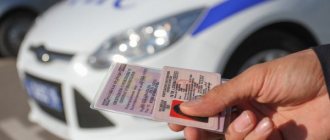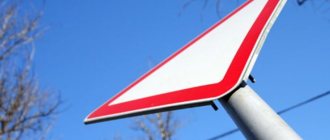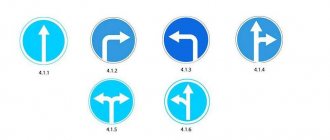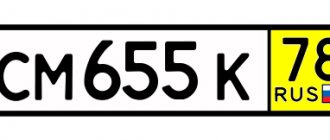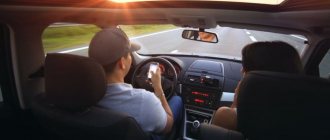Visual traffic control symbols may be installed for a limited period. They differ from stationary ones in appearance, but sometimes drivers confuse the temporary sign with the permanent one located on the yellow-green board. In addition, many are confident that they will not face anything for ignoring the requirements of the current limited-term symbol.
Read about what temporary road signs are, where and how they are installed, as well as the rules they dictate.
Temporary road signs in traffic regulations and their features
The traffic rules stipulate that the following symbols can be valid for a limited period:
- 1.8, notifying that traffic is regulated by a traffic light;
- 1.15, installed on slippery surfaces;
- 1.16, informing about uneven roads;
- 1.18, warning about the release of gravel under the wheels of the car;
- 1.20.1-1.20.3, installed before the narrowing of the web;
- 1.21, notifying about the establishment of two-way traffic;
- 1.25, informing about road works;
- 1.32, indicating that there is a traffic jam on the way;
- 1.33, warning of danger;
- 1.34.1, 1.34.2, indicating the direction of rotation;
- 2.5, prohibiting driving without stopping;
- 2.6, determining the advantage of oncoming traffic;
- 2.7, limiting the scope of the previous pointer;
- 3.20, prohibiting overtaking in the area;
- 3.21, terminating 3.20;
- 3.24, limiting the maximum permitted speed;
- 3.25, completing the zone of influence of the previous symbol;
- 4.2.1-4.2.3, indicating the need to go around an obstacle;
- 6.17, showing the detour scheme;
- 6.18.1-6.18.3, showing the direction in which to avoid the obstacle;
- 6.19.1, 6.19.2, establishing the need to change lanes to another carriageway when the first one is closed to traffic.
But taking into account specific conditions, any designation can be established for a limited period.
According to traffic regulations, temporary road signs are often combined with each other and supplemented with signs that clarify the territory of their influence or indicate the distance to the problem area. Some of them are rare. Others can be seen in populated areas as well as on highways.
We recommend reading about what traffic markings are like on the road. From the article you will learn about the types of markings according to traffic regulations, what markings mean depending on color and application, what to do if the markings are not visible on the road. And here is more information about how to follow the “Main Road” road sign.
What are temporary road signs?
All drivers know that road signs that are installed on a permanent basis have a white background. The traffic regulations also provide for temporary road construction elements. Most often they can be seen during road works. They have a yellow background.
Did you know? In 1683, Emperor Peter I signed a decree regulating travel in St. Petersburg: the document introduced maneuvering on the right side, prohibited driving too fast and hitting passers-by with a whip. Those who disobeyed were supposed to be sent to hard labor.
Yellow temporary signs are:
- warning;
- prohibiting.
Yellow temporary signs
Their meaning:
- 1.20.1–1.20.3 - symbols with such images can be seen in places before the narrowing of the roadway;
- 1.15 - the image on the sign indicates that a slippery surface awaits you ahead;
- 1.16 - bumps mean an uneven road ahead;
- 1.8 - installed on a roadway regulated by a traffic light;
- 1.19 - installed in places with a dangerous shoulder near the roadway;
- 1.21 - warns about the start of two-way traffic;
- 1.33 - warns of danger;
- 2.6 - notifies the driver of the advantage of oncoming traffic;
- 3.11 - it is prohibited to exceed the weight of the load indicated on the plate in the vehicle;
- 3.12 - in this case we are talking about limiting the mass of the load on the axle of the vehicle;
- 3.13 - the height of the vehicle must not exceed the number on the plate;
- 3.14 - the width of the vehicle must not exceed the number on the plate;
- 3.15 - the length of the vehicle must not exceed the number on the plate;
- 3.16 - the distance between vehicles should not exceed the number on the plate;
- 3.18.1–3.19 - movement in the direction of the arrow is prohibited;
- 3.20 - installed in places where overtaking is prohibited;
- 3.21 - end of the previous rule;
- 3.22 - installed in places where overtaking of freight vehicles is prohibited;
- 3.23 - end of the previous rule;
- 3.24 - it is prohibited to exceed the speed indicated on the plate;
- 3.25 - end of the previous rule.
Important! There is no need to confuse temporary signs with permanent ones, which are placed on yellow shields, but the symbol itself is on a white background. Yellow boards are installed in places with an increased likelihood of accidents to attract attention.
Speed limits
Temporary "Speed Limit" road signs are usually used where repairs are underway, a detour is required, or you have to drive along a narrow section. And driving fast can lead to an accident.
3.24 yellow is often combined with the symbols 3.20, 4.2.1-4.2.3, 1.15,1.16, 1.18 or 1.20.1-1.20.3. Sometimes several speed limit indicators are placed one after another so that cars reduce it smoothly. For example, on the first segment it should be no more than 70 km/h, on the next – up to 50 km/h, on the final – up to 40 km/h.
And next to 3.24 there may be a sign 8.2.1. It shows the length of the section along which you should drive at a limited speed. If it is not there, you should look for symbol 3.25, which completes the area of influence of 3.24.
Action of the speed limit sign
Symbol 3.24 means for motorists and motorcyclists a ban on driving at a higher speed than indicated on it. Its use is dictated by safety considerations, since it is placed on sections with sharp turns, poor visibility, poor quality of the road surface, and other problem areas.
The operation of the “Speed Limit” sign has the following features:
- If a new symbol 3.24 appears on the way, with a different maximum permissible value of the auto indicator. On the first it could be 40 km/h, on the second – 60 km/h. From the next character you can increase the indicator to the allowed value. That is, the first one ceases to operate from the place where the second one is fixed.
- If there are signs canceling the speed limit. These are 3.25 and 3.31. In the first case, there is an indication of the termination of the ban established by symbol 3.24. In the second, all restrictions that were regulated by other road signs are removed.
- If there is an intersection on the way. In the absence of other designations, the coverage area of 3.24 may end there. This does not apply to exits from the adjacent territory, into a field or onto a secondary road. That is, with the signs at the intersection 2.3.2-2.3.7, it is still impossible to drive a car faster.
- If a city or village begins or ends on the way. In the first case, you can accelerate after the designation 5.23.1 or 5.23.2. In the second, the prohibition to drive faster ceases to apply on signs 5.24.1 or 5.24.2. But residential speed limit signs may require even more if a residential zone begins immediately. After all, according to traffic regulations, the indicator in this case should not exceed 20 km/h.
- If sign 8.2.1 is located nearby, it determines the extent of the territory where 3.24 applies. The distance is usually indicated in meters, and the auxiliary symbol is hung below the main one.
The “Speed Limit” road sign should not contradict another important requirement of the traffic rules. This especially applies to the situation when two 3.24 symbols are installed on sections of the road adjacent to each other. They should not force vehicles to slow down sharply, i.e. by more than 20 km/h.
More on AutoLex.Net:
The last group of symbols from Appendix 1 of the Traffic Regulations are additional information signs: characteristics, features
If the first symbol contains the number 60, and the next one 20, the second symbol is installed in violation of traffic regulations. The maximum permissible indicator in this case can be 50, 40, but not less.
If in the area of action 3.24 there is a pedestrian crossing, a bridge, a turn without an intersection, a tunnel, or a traffic light for pedestrians, the speed limit prescribed by it must be maintained.
During road works
It is temporary signs during road works that can be found most often. They are almost never permanent, that is, with a white background.
1.25 requires special attention from drivers. In its coverage area there is not only a problem road, but also special equipment, materials and workers. Here it is necessary to reduce the speed, so symbol 3.24 is installed nearby. Crushed stone may fly from the road under the wheels, which will be warned by designation 1.18. And the width of the area left for travel is reduced, so from 1.25 signs 1.20.1-1.20.3 are fixed.
If the section under repair needs to be bypassed, drivers will see symbols 6.17 or 6.18.1-6.18.3. Additional signs (but not plates) must also be yellow.
1.25 has installation features:
Sign 1.25 when carrying out short-term work on the roadway can be installed without sign 8.1.1 at a distance of 10 - 15 m from the work site.
And outside the city or village it is repeated 50 m before the dangerous segment. In populated areas, 1.25 is placed directly in front of the area being repaired.
Installing speed limit signs
How symbols 3.24 should be used is described in the Methodological Recommendations of the Ministry of Internal Affairs and GOST R 52289-2004. Installation of speed limit signs must meet the following requirements:
- they must be located at a distance of 150-300 m from a dangerous area outside a populated area and at a distance of 50-100 m from it in a city or village;
- if the road in their area of operation has two or more lanes, 3.24 is duplicated on the dividing line;
- they do the same if it is not there, but there is oncoming traffic (the symbol is also placed to the left of the roadway with 1-2 lanes or above it with 3 or more lanes);
- if the area where you cannot drive quickly is large, the change in speed limit should be stepped (several signs are installed with gradually decreasing values of the maximum indicator);
- the previous rule does not apply if the symbol is used in front of a populated area and it is visible from more than 150 m.
More on AutoLex.Net:
Designation options and features of passage to the “Bicycle path” sign: beginning, end of the path
An important condition for use is that the “Speed Limit” sign must be clearly visible from a distance of at least 100 m. And the value of the maximum permissible indicator for it is chosen taking into account the terrain, the intensity of traffic and pedestrians. 3.24 will protect you from accidents on descents, sharp turns, on bridges, narrow roads, etc.
Watch this video about the pitfalls when placing speed limit signs:
Portable and yellow
Yellow temporary road signs are often confused with permanent ones located on a rectangular base of the same color. But in the second case, this background is external. Inside, the permanent symbol is white and the main image is drawn on it. And the yellow-green surroundings make it easier to see in the dark.
The temporary indicator has a yellow background inside the border. It contains the main image. Simultaneously with the installation of non-permanent signs, permanent signs must be removed or hidden. But they often remain visible.
A characteristic feature of symbols used for a limited period is the installation method. They can be placed directly on the roadway in the form of a “clamshell”. Portable temporary road signs are easier and faster to install and remove. In addition, several signs can be placed on one folding support at once. The method is legalized by GOST:
In places where work is being carried out on the road and during temporary operational changes in the organization of traffic, signs on portable supports may be installed on the roadway, roadsides and dividing strip.
Validity area of temporary signs
Yellow traffic control symbols are not only limited in terms of their use. The coverage area of temporary road signs is also not endless. It may be limited to:
- Another symbol signifying the end of the territory of influence of the previous one. For example, for a section with a speed limit it is 3.25. The second pointer should also be yellow.
- Table 8.2.1. It shows at what distance the sign attached next to it is valid and is installed with a repeat symbol.
- Tables 8.2.2, 8.2.3. Used less frequently.
- Index 3.31. It means the completion of all restrictions imposed up to this point.
If there are no listed symbols (which is rare), the territory of influence ends at the intersection closest to the installation site or at the beginning (end) of a populated area.
Installation according to GOST
GOST R 52289-2004 requires temporary road signs to be mounted in a special way. In case of poor visibility, they are duplicated on the left side of the track, the dividing strip. Restricted symbols are located at a distance of at least 50 m from each other if we are talking about a section outside a city or village. And in populated areas it should be 25 m.
There are special installation requirements for some signs:
Outside populated areas, signs 1.1, 1.2, 1.9, 1.10, 1.23 and 1.25 are repeated. The second sign is installed at a distance of at least 50 m before the start of the dangerous section. Signs 1.23 and 1.25 are also repeated in populated areas immediately at the beginning of the dangerous section.
There is also this condition:
Signs are installed immediately in front of an intersection, a turnaround point, a service facility, etc., and if necessary, at a distance of no more than 25 m in populated areas and 50 m outside populated areas in front of them, except in cases specified by this standard.
Expert opinion
Nadezhda Smirnova
Automotive Law Expert
That is, some non-permanent symbols are installed directly in front of a difficult section where you need to change the driving mode, while others are also installed several tens of meters before it.
Features of installing temporary signs
All signs are mounted in accordance with the current standard, in particular GOST of 2004, number 522589:
- Within the city limits they are placed 100 m from the beginning of the repaired area.
- Signs on a yellow background are mounted at a distance of no more than 25 meters from each other, and outside populated areas - no further than 50 meters.
- They can be mounted on tripods, stands, portable supports for road signs, the sides of repair service vehicles and other mounting means.
- If the area is poorly illuminated, they are placed not only in the direction of traffic, but also on the opposite side, in the center of the road.
- All other signs are preceded by a road works sign.
- On dangerous sections of highways, structures indicating the speed limit are installed every 100 meters.
- Temporary signs are placed directly in front of the obstacle, and additional information about avoidance methods may also be provided there.
Travel fine
The fine for temporary road signs, or rather driving under them not according to the rules, can be at least 500 rubles. There is part 1 of article 12.16 of the Administrative Code. But if the driver turned left or turned around the wrong way, stopped or parked, he will give 1000-1500 rubles.
We recommend reading about what road safety means. From the article you will learn about the road safety management organization responsible for its implementation. Here's more about the main warning signs.
Temporary road signs are a common cause of penalties. Because of them, it is difficult to change the usual driving habits on a well-known section of the road. And yet you will have to do this, because now you can be fined for a violation even if it is recorded by a video camera.

